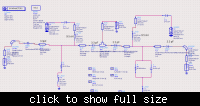usman_mahfooz
Member level 2
I need some help here. When measuring resistance on my pin diode in forward bias condition i am geting a reading of -9000 Mohms. It should be < 2 ohm.Circuit is of a spdt switch.
Can somebody tell me why its behaving in such a way.
NOTE I am not switching the bias current i-e keeping the diode in a single state)
I am not switching the bias current i-e keeping the diode in a single state)
Thanks
Can somebody tell me why its behaving in such a way.
NOTE
Thanks
Last edited:


